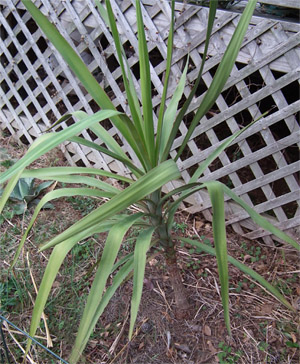Jalisco Soapwort facts for kids
Quick facts for kids Jalisco SoapwortIzote |
|
|---|---|
 |
|
| Yucca jaliscensis | |
| Conservation status | |
| Scientific classification | |
| Synonyms | |
|
Yucca jaliscensis is a type of plant in the Yucca family. It grows naturally in the mountains of southwestern Mexico. People often call it the Jalisco Yucca, Jalisco Soapwort, or Izote Yucca. You can find this plant in mountain areas, usually around 5,000 feet high, in the Mexican states of Jalisco, Colima, and Guanajuato.
Contents
What Does the Jalisco Yucca Look Like?
The Yucca jaliscensis is a tall plant that looks like a tree. When it's very old, it can grow up to 10 m (33 ft) tall and spread out to 6 m (20 ft) wide. However, it's usually found at less than 7.5 m (25 ft) in height.
This plant can have a thick base for its trunk. It might have a single trunk or several trunks growing together. The trunk base is often about 0.5 to 2 feet wide. Very old plants can have trunks over 4 or 5 feet wide! Usually, about 5 to 8 branches grow straight up from the short trunk, with leaves at the top of each branch.
The leaves are long and thin, like straps. They can be stiff or a bit bendy, and their color ranges from blue to green. They don't have spines and can be up to 1 m (3 ft) long and 8 cm (3 in) wide. Older leaves usually fall off the trunk by themselves over time.
The flowers of the Yucca jaliscensis are white and shaped like balls. They usually bloom from September to May, but sometimes you can see them almost any time of the year. These flowers are about 2 to 3.5 cm long and 1 to 1.5 cm wide. The plant also produces fruits that are 4–5 cm wide.
Where Does the Jalisco Yucca Grow?
The Yucca jaliscensis grows in Mexico, close to the Pacific coast. You can find it in the states of Jalisco, Colima, and Guanajuato. It likes to grow on flat lands and small hills, usually between 3,000 and 7,000 feet high.
In the wild, you might find this yucca in forested ravines or narrow stream gorges. It often grows in forests with pine, oak, or other broad-leaved trees, especially near winding streams. It can also be found on dry hills or steep, rocky volcanic slopes. Sometimes, it even grows in open fields where crops like corn are planted.
This plant is often grown as an ornamental plant around homes or towns. Because of this, it's not seen as often in its natural wild habitats.
How Did the Jalisco Yucca Get Its Name?
The scientific name for this plant today is Yucca jaliscensis. The first time this name was used was in 1920 by a scientist named William Trelease.
Before that, in 1902, Trelease thought this plant was just a type of Y. × schottii. But later studies showed that it was clearly a different species. It was much more branched and larger overall than Yucca schottii. So, Trelease decided to give it its own name, Yucca jaliscensis. He named it after the area where it is found, which is Jalisco, Mexico.
Growing the Jalisco Yucca
The Yucca jaliscensis can grow in many different types of soil. It doesn't need a lot of water, so it's good at handling dry conditions. This plant is quite rare and doesn't grow in many places. It is closely related to other yucca species like Yucca schottii, Yucca madrensis, and Yucca grandiflora.
Not many people grow Yucca jaliscensis in their gardens because it's not very well known. However, it has shown that it can survive cold temperatures. For example, in Albuquerque, New Mexico, where temperatures can drop below 5°F, old Yucca jaliscensis plants have done well in dry conditions.
You can grow new Yucca jaliscensis plants from small shoots that grow from the base of the plant, from cuttings, or from seeds.
See also
 In Spanish: Yucca jaliscensis para niños
In Spanish: Yucca jaliscensis para niños


